Amarnath Yatra Quick Information
At a height of 3,888 m at the farther end of Lidder Valley
Very unpredictable. Sunny weather may turn into rain / snow fall in no time. The temperature may fall upto -5 degree C.
Amarnath Yatra
This is one of the most onerous but very thrilling and exciting pilgrimages in India that is popular with the Shiva devotees. Perched at a height of 3,888 m at the farther end of Lidder Valley in the beautiful state of Jammu and Kashmir, there is a cave (150 ft high and 90 ft long) that Lord Shiva chose to divulge the secret of immortality to his inquisitive consort Goddess Parvati. A secret, that was not to be heard by anyone else but for the goddess.
Approach To The Cave
Devotees can reach the holy cave either by trekking or on ponies or in helicopters.
1. Helicopter service : Helicopter services are available from Srinagar and also from Baltal. The flying time from Srinagar to Baltal is around 45 minutes and from Baltal to the Holy Cave is around 10 minutes. Flights start at 6.30 a.m. and continue through the day subject to weather conditions. The reporting time is 1 hr prior to the time of departure. The helicopters drop the pilgrims near the cave. They just have to climb a few stairs to the cave for the glimpse of the pious lingam.
2. Trekking : The cave can be approached from two sides – either from Baltal or from Chandanwari.
Chandanwari -Pissu Top (3 km)-Seshnag (9 km)-Panchtarni (12 km)-Amarnath Cave (6 km)
This is a longer route but is considered more sacred as it is through this route that Chhari Mubarak, the holy mace of Lord Shiva, reaches the cave shrine. Night-stay facilities are only available at Pahalgam, Seshnag, Panchtarni and the holy cave (though most yatris on this route return to Panchtarni on the day of the darshan itself).
Baltal-Domail (2 km)-Burari Marg (5 km)-Sangam Ghati (4 km)-Amarnath Cave (3 km)
This route is shorter but then it is steeper and is more prone to landslides. Accommodation tents are available only at Baltal and the cave. So, the entire stretch has to be covered in a single day.
Going to the cave from the side of Chandanwari and returning back to Baltal is a good idea as one can easily climb down to Baltal in 4-5 hours (subject to weather conditions).
Pony and Dandies (palki) Service : Ponies or dandies can be hired from any of the night halt camp areas on the way. Many people prefer to trek for some distance and then hire a pony when they get tired. Ponies and dandies usually take the same route as of the trekkers for most part of the journey.
TREK & TOUR : Amarnath Yatra
Highlights:
- Divine Sheshnaag lake (trek via Pahalgam only)
- Scaling mountains, crossing streams, doing ice walks
- Devotees chanting together “Jai Bhole ki
- Free kitchen service
- Awe-inspiring scenic beauty
HELICOPTER TOUR : 03 DAYS AMARNATH YATRA
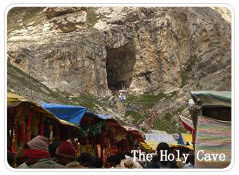 Day 1: Srinagar Airport – Sonmarg (100 Kms)
Day 1: Srinagar Airport – Sonmarg (100 Kms)
On arrival at Srinagar, you will be met by our representative and transferred to Sonmarg which will take you about 3 hours. Check in at the hotels for overnight stay.
Day 2: Sonmarg – Baltal – Amarnath – Baltal – Srinagar
After early breakfast short drive of 15 Kms will take you to Baltal (Helipad) where you board the helicopter and fly to Panchtarni. From Panchtarni to Amarnath Ji it is about 5/6 Kms by foot / Horse / Palki which will take about 1 hour to the cave depending upon the rush of the other pilgrims. On the retur take the helicopter back to Baltal and 3 hours drive will take you to Srinagar. Dinner and overnight at the hotel.
Day 3: Srinagar
After breakfast enjoy a Shikara Ride on the dal lake and later drive towards Srinagar airport for onwards journey.
Tour Cost (Excluding GST of 3.09%, Valid for year 2013 only)
2 Persons @ INR 17000 person (Extra bed @ INR 12500 per person)
Tour Inclusions
Welsome drink or tea with cookies at the time of arrival into the houseboat only, helicopter tickets for Baltal / Panchtarni / Baltal, all transfers and complete transportation by Non AC Vehicle, Daily breakfast and dinner and arrival assistance.
AMARNATH YATRA : TREK VIA PAHALGAM (05 DAYS)
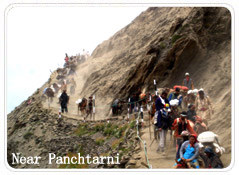 Day 1: Srinagar
Day 1: Srinagar
On arrival at Srinagar, you will be met by our representative at the airport and transferred to Deluxe Houseboat. Afternoon free for personal activities. Overnight at Houseboat.
Day 2: Srinagar – Pahalgam (93 Kms drive)
Leave Srinagar by for Pahalgam (2440 Mtrs). Enroute visit Saffron fields and Avantipur ruins. On the way see some more beautiful villages. Pahalgam is the most famous place for Indian Film Industry. Enjoy the natural charm of the valley. Overnight at Hotel.
Day 3: Pahalgam – Chandanwari (2895 M) 13 Kms drive – Sheshnagh 14 Kms trek
Leave after early breakfast from Pahalgam to Chandanwari by car. Immediately starts trekking ascending towards Sheshnagh which is a 12 Kms trek. The trek is a steep ascend towards Pishoo Ghati pass (13000 Fts). Overnight in tents at Sheshnagh.
Day 4: Sheshnagh (3377 M) – Panchtarni 14 Kms trek – Amarnath – Baltal – Sonmarg
Start early morning for a steep ascent upto Mahagunas (The great Viper 14500 Ft) then as easy descend upto Panchtarni situated at the foot of mount Bhairva where you will stop for lunch and immediately start with ups and downs walk upto Panchartani where you will stop for lunch and immediately start another 6 Kms trek to Amarnath ji Holy Cave (3593 M) where you can see the Ice Lingam. This is the holy cave for Hindus & thousands of people visit the place during full Moon day. From Amarnath steep descend towards Baltal is just a 3/4 hrs walk. From Baltal it is a 15 Kms drive to Sonmarg. Sonmarg (2690 Mtrs) which is the most beautiful spot of Kashmir valley. Sonmarg is known as Gateway of Ladakh. Overnight at Hotel.
Day 5: Sonmarg – Srinagar (113 Kms drive)
After breakfast drive towards Srinagar airport for onwards journey.
Tour Cost (Excluding GST of 3.09%, Valid for year 2013 only)
2 Persons @ INR 15400 person (Extra bed @ INR 7500 per person)
Tour Inclusions
Transfers and complete transportation by Non AC Vehicle, Camping Accommodation on Room Only Basis, Accommodation at Sonmarg, Pahalgan and Srinagar with breakfast and dinner, Amarnath registration formalities and arrival assistance.
AMARNATH YATRA : TREK VIA SONMARG / BALTAL (05 DAYS)
 Day 1: Srinagar
Day 1: Srinagar
On arrival at Srinagar, you will be met by our representative at the airport and transferred to Deluxe Houseboat. Afternoon free for personal activities. Overnight at Houseboat.
Day 2: Srinagar – Sonmarg – Baltal (113 Kms)
Drive to Sonmarg (2690 Mtrs) which is the most beautiful drive from Srinagar. On the way we stop at many beautiful spots. Lunch at Sonamarg and then drive to Baltal which will take you 1 hour from Sonmarg. Overnight in tents.
Day 3: Baltal – Amrnath – Baltal (32 Kms return)
Leave early morning for Amarnath Holy Cave (3953 M) where you can see the Ice Lingan. This is the Holy Cave for Hindus and thousans of people visit the place during the full moon day. From Amarnath steep descent towards Baltal (4 hours walk). Overnight in tents.
Day 4: Baltal – Sinmarg – Srinagar (113 Kms)
After breakfast leave for Srinagr to reach there by lunch time. Afternoon free for personal activities. Overnight on Houseboat.
Day 5: Srinagar
After breakfast drive towards Srinagar airport for onwards journey.
Tour Cost (Excluding GST of 3.09%, Valid for year 2013 only)
2 Persons @ INR 14500 person (Extra bed @ INR 3500 per person)
Tour Inclusions
Transfers and complete transportation by Non AC Vehicle, Camping Accommodation on Room Only Basis, Accommodation at Sonmarg, Pahalgan and Srinagar with breakfast and dinner, Amarnath registration formalities and arrival assistance.
AN ARDUOUS BUT REWARDING JOURNEY
 Sacling the mist swirled mountains. crossing the streams, doing an ice walk and battling low atmospheric pressure may be adventure for some but it is the test of devotion for most of those who undertake the holy Amarnath Yatra.
Sacling the mist swirled mountains. crossing the streams, doing an ice walk and battling low atmospheric pressure may be adventure for some but it is the test of devotion for most of those who undertake the holy Amarnath Yatra.
The months of July and August have a great significance in the religious calendar of India, for these are the only two months of the year when the Shiva devotees can get a glimpse of their innocent lord (Bholenath) at Amarnath cave. Perched at a height of 3,888 m at the farther end of Lidder Valley in the beautiful state of Jammu and Kashmir, this cave is the site that Lord Shiva chose to divulge the secret of immortality to his inquisitive consort Goddess Parvati. On reaching there you will yourself realize, what better place could he have chosen for narrating the amar katha (tale of immortality) that was not to be heard by anyone else but for the goddess.
Legend has it that once Parvati asked lord Shiva as to why he wears a mundmala (garland of heads) round his neck. Shiva replied that, these heads symbolize her death and reincarnation and every time she died he added a new head to his garland. On this when Parvati inquired the reason for her reincarnations and the immortality of Shiva, the lord decided to narrate the amar katha to her.
As the tale was not to be heard by anyone else, Bholenath left his vahan (vehicle) Nandi bull at Pahalgam, his moon at Chandanwari, his serpent at Sheshnag, his son Lord Ganesh at Mahugunas, and the five elements namely earth, water, fire, air & sky (of which the human body is comprised of) at Panchtarni. He ordered the fire god to destroy everything in and around the cave so that even a trace of life was not left there. While the story was still incomplete, goddess Parvati unfortunately dozed off and missed the secret of immortality. It was, however, heard by a pair of pigeons who escaped fury of fire as they were inside an egg shell that hid beneath the tiger hide on which Lord Shiva himself was sitting. Consequently, they became immortal and can be spotted even to this day inside the cave.
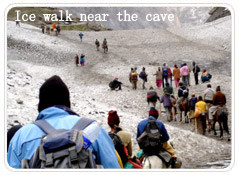
For the mortals like us, the cave was discovered by a shepherd called Buta Malik. Once when Buta Malik was grazing his sheep a sage gave a bag full of coal at this place. On reaching home, to his surprise, he found the bag was full of gold. Overwhelmed Buta Malik rushed back to the cave to express his gratitude to the sage, but was awestruck to find only an ice lingam inside the cave. From that day onwards began a tradition of going on pilgrimage to this holy site. The descendents of Buta Malik are even today given a definite share from the offerings to Lord Amarnath.
The cave can be approached from two places – from Pahalgam (96 km from Srinagar & 46 km from Cave) and Baltal (115 km from Srinagar & 16 km from cave). The distance from Baltal is short but exhausting, if you decide to trek to the cave from here, as most of the time you will be going uphill. Contrarily, it is definitely a good choice to climb down from this side for the obvious reason that it will be mostly downhill. Those who have severe scarcity of time and energy can fly from Srinagar or Baltal in helicopters straight to the holy cave.
 Being aware of our stamina we decided to climb from the side of Pahalgam, which is a longer trek but then to our relief it comprised of regular ascends and descends. Our trek actually started from Chandanwari (16 km from Pahalgam), which is accessible by bus or car. The religious fervor that swathes the whole journey makes its first strong appearance at Chandanwari. You can see people milling on the street before embarking on the arduous trail. Here begins the chain of langars (free kitchen services) that dot the way to the cave. The banners outside these langar tents read the names of the devotees who make handsome donations to serve the yatris. The devotees address each other as ‘BHOLE’. The idea is to maximize the number of times they repeat the name of their lord Bholenath. Passing through one of such langars, I heard someone calling us saying “bhole kuch to khakar jao” (“Bhole! Please have something before proceeding”). It was such a gentle and earnest request that we could not deny it anyway and stopped for tea and some snacks. We bought a stick for ourselves as it helps the trekkers in steadying themselves on a snow covered slippery path and commenced our journey with the note of “Har Har Mahadev”.
Being aware of our stamina we decided to climb from the side of Pahalgam, which is a longer trek but then to our relief it comprised of regular ascends and descends. Our trek actually started from Chandanwari (16 km from Pahalgam), which is accessible by bus or car. The religious fervor that swathes the whole journey makes its first strong appearance at Chandanwari. You can see people milling on the street before embarking on the arduous trail. Here begins the chain of langars (free kitchen services) that dot the way to the cave. The banners outside these langar tents read the names of the devotees who make handsome donations to serve the yatris. The devotees address each other as ‘BHOLE’. The idea is to maximize the number of times they repeat the name of their lord Bholenath. Passing through one of such langars, I heard someone calling us saying “bhole kuch to khakar jao” (“Bhole! Please have something before proceeding”). It was such a gentle and earnest request that we could not deny it anyway and stopped for tea and some snacks. We bought a stick for ourselves as it helps the trekkers in steadying themselves on a snow covered slippery path and commenced our journey with the note of “Har Har Mahadev”.
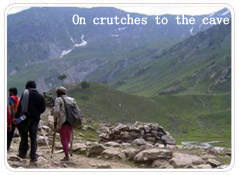 On the way a man gave us small packets of dry fruits and toffees – the former to give you energy and the later to curb the tendency of vomiting while you ascend steep heights. In the first day’s trekking we were supposed to cover 14 km before making a night halt at Seshnag. For the infirm there is an option of hiring horses and ponies or palanquins. Those who are firm enough to undertake the trek but cannot carry their bags along with them can hire men called ‘pithus’ for carrying their luggage. The initial 3 km that lead you to Pissu top are the steepest and, thus, strenuous part of this route. It literally saps all your energy. I made it to the top a bit faster than my friend who complimented me for the same. But before I could absorb the compliment, the bread and tea I had had for my breakfast came out of my mouth in an indecent manner. A lesson that I learnt for the rest of my journey – avoid eating when you have to make steep climbs.
On the way a man gave us small packets of dry fruits and toffees – the former to give you energy and the later to curb the tendency of vomiting while you ascend steep heights. In the first day’s trekking we were supposed to cover 14 km before making a night halt at Seshnag. For the infirm there is an option of hiring horses and ponies or palanquins. Those who are firm enough to undertake the trek but cannot carry their bags along with them can hire men called ‘pithus’ for carrying their luggage. The initial 3 km that lead you to Pissu top are the steepest and, thus, strenuous part of this route. It literally saps all your energy. I made it to the top a bit faster than my friend who complimented me for the same. But before I could absorb the compliment, the bread and tea I had had for my breakfast came out of my mouth in an indecent manner. A lesson that I learnt for the rest of my journey – avoid eating when you have to make steep climbs.
The scene there was startling. The devotees with haggard faces suddenly turned frenetic. All danced in ecstasy to the tunes of the devotional songs played in the langar tents. I wondered from where they derived this energy. It was probably a celebration of overcoming the first hurdle in the way to the seat of their lord. The variety of dishes served there came as a big surprise to me. Gamut of sweets, chats (spicy snacks) including golgappas, aloo tikkis, dahi vadas, idlis, dosas, aloo paranthas and what not – a lavish feast indeed. Like any normal girl, it was difficult for me to resist the temptation of the golgappas. But I restricted myself to quickly gobbling just 2 pieces as remaining 11 km were still to be covered. We took a breather and then moved ahead.
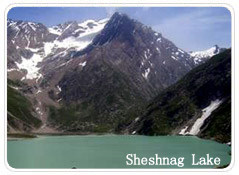 From the more experienced yatris we learnt that the trail from here up to Sheshnag was not going to be as torturous as the distance already covered had been. The Sun was shining brightly overhead casting its spell on our skin (the effect of which became evident after the yatra. My dark and dead skin peeled off like a mask), but at the same time we could experience the cool wind also. It is advisable to cover your body as much as possible and apply good quality sun block lotion to avoid your skin becoming dark, dry and dead.
From the more experienced yatris we learnt that the trail from here up to Sheshnag was not going to be as torturous as the distance already covered had been. The Sun was shining brightly overhead casting its spell on our skin (the effect of which became evident after the yatra. My dark and dead skin peeled off like a mask), but at the same time we could experience the cool wind also. It is advisable to cover your body as much as possible and apply good quality sun block lotion to avoid your skin becoming dark, dry and dead.
We walked and walked scaling the mountains and crossing the streams. Our energy levels gradually declined. The last 3 – 4 km were the most onerous to ambulate. The sight of the bluish green Sheshnag Lake elicited a sigh of relief out of most of the travelers. But our tents were still 1.5 – 2 km away so we just lolled up on the green grass staring at the resplendent lake.
On reaching Wawjan, we booked a tent for night stay. The allotment is done on the first come first serve basis, except for a few JKTDC tents that can be reserved in advance. (It is better to reach earlier and look out for a clean tent because most of them are not so clean. In my opinion carrying your own sleeping bag is more advisable). There are a few common toilets at one side of the camping site. It was 8 in the evening and still not dark. It appeared that the sun sets late and rises early there. By this time the lactic acid deposition in our legs made it almost impossible to move. We, thus, decided to ride on horses up to the cave, the next day, instead of trekking to Panchtarni which was 6 km short of the holy cave.
 Next day after the morning ablutions, I gingerly climbed on my horse for the onward journey. We soon realized that riding a horse in such a rugged terrain is also no cake walk. Each horse is under the command of a horseman who walks side by side. On ascends he instructs his client to lean forward and similarly lean backward at descends. The balance of both legs should also be maintained carefully. The horses usually take the same route as of the trekkers. The passage sometimes becomes very narrow so it becomes difficult to negotiate especially when the trekkers have to share the path with the horses. Although, as a thumb rule the horses walk on the edges giving a safer side to the hikers but the dust that rises when their sturdy hoofs trample the ground settles on their bodies besides making it difficult to breathe.
Next day after the morning ablutions, I gingerly climbed on my horse for the onward journey. We soon realized that riding a horse in such a rugged terrain is also no cake walk. Each horse is under the command of a horseman who walks side by side. On ascends he instructs his client to lean forward and similarly lean backward at descends. The balance of both legs should also be maintained carefully. The horses usually take the same route as of the trekkers. The passage sometimes becomes very narrow so it becomes difficult to negotiate especially when the trekkers have to share the path with the horses. Although, as a thumb rule the horses walk on the edges giving a safer side to the hikers but the dust that rises when their sturdy hoofs trample the ground settles on their bodies besides making it difficult to breathe.
Just a few kilometers from Wawjan, Mahugunas (or Ganesh) top is the highest point (14,500 feet) on the entire route. Air thinned out gradually. People, especially the trekkers, gasped for breath. At such places smelling camphor facilitates breathing. I actually saw many people trying this idea. A kind lady offered us some. The already fatigued muscles were rendering it all the more difficult to scale this steep height. People, now, stopped and leaned on their sticks more frequently. But, the daunting trail could not shatter the spirit of the devotees. Leave aside the physically sound ones; there were a few who were making it on their one leg and some who were bare footed. All continued, incessantly chanting the magic mantra – ‘Om Namah Shivay’ as if these three words became a source of life.
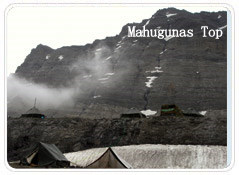 After crossing the Mahugunas and Panchtarni, a meadow land where there is provision for tented accommodation, we again made a steep climb and then descended down for some distance to reach the holy site for Amarnath Cave. At a mere glimpse of it signs of affliction vanished from all faces. The devotees are supposed to take a dip in the icy cold river that flows by its side before approaching the cave. There are a few temporary bathrooms by the side of the river and hot water for Rs 50 per bucket is also available. We quickly took bath and joined the long queue to the cave. The security personnel channel the crowd to ensure orderly movement. The cave is 150 ft high and 90 ft long. Besides the ice lingam there are the two more ice formations – one resembling goddess Parvati and the other Lord Ganesh. It is believed that the water from holy Ramkund Lake situated above the cave, falls drop by drop to form this holy Shiva Lingam.
After crossing the Mahugunas and Panchtarni, a meadow land where there is provision for tented accommodation, we again made a steep climb and then descended down for some distance to reach the holy site for Amarnath Cave. At a mere glimpse of it signs of affliction vanished from all faces. The devotees are supposed to take a dip in the icy cold river that flows by its side before approaching the cave. There are a few temporary bathrooms by the side of the river and hot water for Rs 50 per bucket is also available. We quickly took bath and joined the long queue to the cave. The security personnel channel the crowd to ensure orderly movement. The cave is 150 ft high and 90 ft long. Besides the ice lingam there are the two more ice formations – one resembling goddess Parvati and the other Lord Ganesh. It is believed that the water from holy Ramkund Lake situated above the cave, falls drop by drop to form this holy Shiva Lingam.
The best part about the darshans at Amarnath is that, unlike other famous temples, devotees are not rushed through. The contentment of viewing and interacting with their lord at ease was clear on every face. Inside the cave at two places water falls drop by drop that is collected by the devotees in their cans. We could also spot two white (slightly grey in color) pigeons there.
We made a night stay there in a tent as it was already 5’o clock in the evening and my friend was not well enough to make it back to the base camp at Baltal. The next morning when we woke up it was drizzling. The movement of the pilgrims had already started. Some were retracing the path on which they had come. But we took the route to Baltal. At times, mist swirled around us. The scenery was divinely awesome. But we unfortunately had no time to admire it as the sky was heavily clouded and so there seemed no chances of the rain easing off. Rainfall had made the path all the more treacherous. We were mostly going downhill so we could walk steadily. Then there was a danger zone of about 2-3 km. The incessant rain had triggered land sliding. All rushed through it without failing to instruct us to negotiate the distance as fast as possible. We finally reached Baltal treading the entire distance of 16 km in drizzle. By the grace of God, despite all odds we were back safe. For the next few days we could think and talk of nothing other than our arduous but rewarding journey.
Getting There
| Air | Rail | Road |
|---|---|---|
| The nearest airport is at Srinagar, the summer capital of Jammu and Kashmir. There are regular flights to and from Delhi, Mumbai and Jammu. Widely known as the ‘Paradise on Earth’, Srinagar itself is a very popular tourist destination. | The nearest rail head is at Jammu, the winter capital of India. It is well connected to all major cities of the country. | The trek to the cave begins either from Chandanwari or Baltal. Both these are well connected by road. Chandanwari is 16 km from Pahalgam, which in turn is 96 km from Srinagar and 315 km from Jammu. The distance between Baltal and Srinagar via Sonmarg is 115 km. |
Other FAQ’s / General Information
| Question | Answer |
|---|---|
| Pre-requisites | Pilgrims must have a sound health and must get a registration card. The registration is done by J &K Govt. Tourist Offices, located at Delhi , Mumbai, Calcutta, Chennai, Ahmedabad, Hyderabad, Jammu and Srinagar. |

